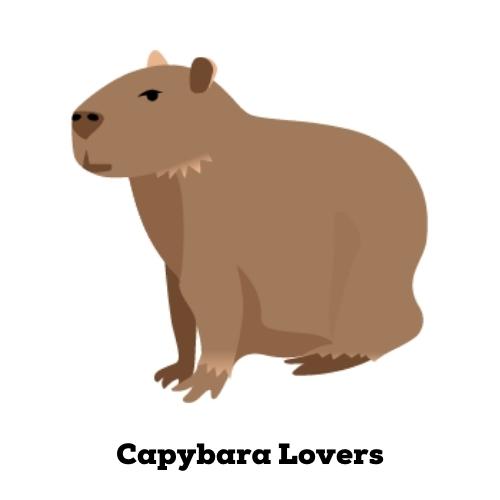
Introduction to Capybara Care
When it comes to pets, capybaras are a unique choice. These large, friendly rodents hail from South America and require specific care to thrive. In this guide, we will introduce you to the world of capybara care, helping you understand their unique needs and why they make such great pets.
- Understanding the unique needs of Capybaras
- Why Capybaras make great pets
Capybaras, being the world’s largest rodents, have needs that differ from your average pet. They are semi-aquatic creatures, meaning they need access to a body of water in which they can swim and cool off. They are also social animals, so they thrive best in the company of their own kind or other friendly animals.
They require a diet rich in grasses and aquatic plants, and they need plenty of space to roam and explore. Understanding these unique needs is the first step towards providing a happy and healthy life for your capybara.
Despite their unique needs, capybaras have a lot of qualities that make them great pets. They are incredibly social creatures, often forming strong bonds with their human caretakers. They are also generally calm and gentle, making them a good choice for families with children.
Moreover, capybaras are known for their intelligence and curiosity. They love to explore their surroundings and can be trained to perform simple tasks. Their friendly and playful nature, combined with their unique appearance, makes them a joy to have around.
In the following sections, we will delve deeper into the specifics of capybara care, including tips on their diet, habitat, health, and behavior. Whether you’re a seasoned capybara owner or just considering bringing one into your home, this guide will provide you with the information you need to ensure your capybara thrives.
Capybara Care Tips
When it comes to the care of Capybaras, there are several key aspects to consider. These include regular veterinary check-ups, the importance of exercise, and proper grooming techniques. Let’s delve into these areas to ensure your Capybara remains healthy and happy.
Keeping Capybaras Healthy
Ensuring the health of your Capybara is paramount. Here are some essential tips:
- Regular veterinary check-ups
- Importance of exercise
- Proper grooming techniques
Just like any other pet, Capybaras require regular veterinary check-ups. These visits allow the vet to monitor the Capybara’s health, catch any potential issues early, and provide necessary vaccinations. It’s recommended to have your Capybara checked at least once a year.
Capybaras are active creatures that need plenty of exercise to stay healthy. Regular exercise helps to keep their weight in check, maintain strong muscles, and promote mental well-being. Activities such as swimming, running, and playing with toys can provide the necessary exercise for your Capybara.
Proper grooming is essential for Capybaras. This includes regular brushing to remove loose hair and prevent matting. Additionally, Capybaras love to swim, so providing a clean water source for swimming can help keep their skin and fur in good condition. Remember to always dry your Capybara thoroughly after swimming to prevent skin issues.
By following these tips, you can ensure your Capybara stays healthy and enjoys a high quality of life. Remember, a healthy Capybara is a happy Capybara!
Happy Capybara Pets
Keeping a capybara happy and content is a crucial part of their care. There are two main ways to ensure your capybara pet is happy: providing mental stimulation and ensuring they have social interaction.
- Providing Mental Stimulation
Capybaras are intelligent creatures that need mental stimulation to stay happy and healthy. Just like humans, they can get bored if they don’t have enough to do. You can provide mental stimulation for your capybara by introducing new toys, creating fun environments for them to explore, and engaging them in play. For example, you could set up a small obstacle course in their enclosure or hide their favorite treats for them to find. This will keep their minds active and prevent them from becoming bored or depressed.
- Importance of Social Interaction
Capybaras are highly social animals. In the wild, they live in large groups, and they thrive on social interaction. If they are kept alone, they can become lonely and depressed. Therefore, it’s important to spend quality time with your capybara pet every day. This could involve playing with them, grooming them, or simply sitting with them. If possible, consider getting a second capybara so they can keep each other company. Remember, a happy capybara is a social capybara!
In conclusion, providing mental stimulation and ensuring social interaction are key to keeping your capybara pet happy. By taking the time to engage with your capybara and providing them with a stimulating environment, you can ensure they live a happy and fulfilling life.
Capybara Companions
When it comes to the social life of capybaras, companionship is key. These friendly creatures are known for their sociable nature and thrive in the company of others. In this section, we will explore how to choose the right companion for your capybara.
Choosing the Right Companion for Your Capybara
Choosing the right companion for your capybara is a crucial step in ensuring their happiness and well-being. Here are a few factors to consider:
- Considering other pets in the household
- Introducing new companions
Before introducing a new companion to your capybara, it’s important to consider the other pets in your household. Capybaras get along well with many types of animals, but they can be intimidated by aggressive or overly energetic pets. Make sure to monitor interactions closely and provide separate spaces if necessary.
When introducing a new companion to your capybara, patience is key. Start by allowing them to interact in a controlled environment, gradually increasing the time they spend together. Remember, it’s normal for there to be some initial hesitation or uncertainty. With time, most capybaras will warm up to their new companions.
In conclusion, choosing the right companion for your capybara involves careful consideration of your existing pets and a patient introduction process. By following these steps, you can help ensure a harmonious household for all your pets.
Capybara Diet
Understanding the dietary needs of a Capybara is crucial for their health and well-being. Just like humans, Capybaras need a balanced diet to stay healthy. Let’s delve into the recommended foods for Capybaras and the foods they should avoid.
- Recommended foods for Capybaras
- Hay: This should make up the majority of their diet. It helps with digestion and dental health.
- Fresh vegetables: Carrots, bell peppers, and leafy greens are excellent choices.
- Fruits: Fruits should be given in moderation due to their high sugar content. Apples, bananas, and berries are good options.
- Pellets: Specially formulated Capybara pellets can supplement their diet and provide essential nutrients.
- Foods to avoid
- Processed foods: Foods that are high in sugar, salt, or artificial additives can be harmful to Capybaras.
- Dairy products: Capybaras are lactose intolerant, so avoid giving them milk, cheese, or other dairy products.
- Meat: As herbivores, Capybaras do not eat meat. Feeding them meat can cause serious health problems.
Capybaras are herbivores, which means they only eat plant-based foods. They love to munch on a variety of grasses and aquatic plants. In the wild, they also eat fruits, vegetables, and tree bark. If you’re caring for a Capybara, you can feed them a diet similar to that of a guinea pig or rabbit, which includes:
Just as there are foods that Capybaras love, there are also foods that can harm them. Here are some foods you should avoid giving to your Capybara:
Remember, every Capybara is unique and may have different dietary needs. Always consult with a vet or a Capybara expert to ensure your pet is getting the right nutrition.
Capybara Habitat
Understanding the natural habitat of a capybara is crucial for creating a comfortable environment for them. Capybaras, the world’s largest rodents, are native to South America and thrive in environments close to bodies of water. They are semi-aquatic creatures and love to swim. Therefore, their habitat, whether indoor or outdoor, should mimic these natural conditions as closely as possible.
Creating a Comfortable Environment
When it comes to creating a comfortable environment for your capybara, there are several factors to consider. These include deciding between an indoor and outdoor habitat and understanding the essential elements of a capybara enclosure.
- Indoor vs. Outdoor Habitats
- Essential Elements of a Capybara Enclosure
- Water Area: As semi-aquatic animals, capybaras need a large water area where they can swim and play. This can be a large tub for indoor habitats or a pond for outdoor ones.
- Shelter: Capybaras need a sheltered area where they can rest and hide. This could be a large box or a small shed.
- Food and Water Dishes: Capybaras should have access to fresh food and water at all times.
- Exercise Area: Capybaras are active animals and need plenty of space to move around and play.
Both indoor and outdoor habitats can be suitable for capybaras, depending on the climate and available space. Indoor habitats should be spacious and have a dedicated area for swimming. Outdoor habitats, on the other hand, should be securely fenced to prevent escape and should also include a large water area. Regardless of the type of habitat, it’s essential to provide plenty of room for your capybara to move around and exercise.
A capybara enclosure should have several essential elements to ensure the comfort and health of the animal. These include:
Remember, the goal is to mimic the capybara’s natural habitat as closely as possible. This will help ensure your capybara is comfortable, happy, and healthy.
Capybara Health
Caring for a capybara’s health is crucial for their overall well-being. Just like any other pet, capybaras can experience health issues. Understanding these common health problems and how to prevent them can help you keep your capybara healthy and happy.
Common Health Issues
Capybaras are generally healthy animals, but they can suffer from certain health issues. Here are some of the most common health problems capybaras may encounter:
- Respiratory infections: Capybaras can suffer from respiratory infections, especially if they are exposed to cold and damp conditions.
- Dental problems: Like other rodents, capybaras’ teeth continuously grow. If they don’t have enough hard materials to chew on, their teeth can overgrow, leading to serious dental problems.
- Parasites: Capybaras can be affected by external parasites like ticks and fleas, and internal parasites like worms.
- Obesity: Capybaras love to eat, and if not monitored, they can become overweight, leading to various health problems.
Recognizing Signs of Illness
Early detection of illness in capybaras can make a big difference in their health. Here are some signs to look out for:
- Changes in behavior: If your capybara is less active than usual, or showing signs of aggression, it could be a sign of illness.
- Loss of appetite: If your capybara is eating less than usual, or not eating at all, it could be a sign of a health problem.
- Changes in stool: Changes in the color, consistency, or frequency of your capybara’s stool can indicate a health issue.
- Weight loss: Sudden weight loss can be a sign of illness in capybaras.
Preventative Care
Preventative care is key to keeping your capybara healthy. Here are some steps you can take:
- Regular vet check-ups: Regular visits to the vet can help detect any potential health issues early.
- Proper diet: Feeding your capybara a balanced diet can help prevent obesity and other health problems.
- Exercise: Regular exercise can help keep your capybara’s weight in check and promote overall health.
- Parasite control: Regular parasite control treatments can help prevent infestations.
Capybara Behavior
Understanding the behavior of a capybara is key to providing them with the best care possible. Capybaras, like any other animal, have unique ways of communicating their feelings and needs. Let’s dive deeper into the world of capybara behavior and communication.
Understanding Capybara Communication
Capybaras communicate through a variety of methods, including vocalizations, body language, and even scent marking. Understanding these behaviors can help you better care for your capybara and respond to their needs.
- Common Capybara behaviors and what they mean
- How to respond to your Capybara’s needs
Capybaras have a range of behaviors that they use to communicate. For instance, when a capybara is happy, they may purr or make a soft whistling sound. If they are feeling threatened, they may hiss or growl. Capybaras also use body language to communicate. A relaxed capybara may lie on its side or back, while a stressed capybara may stand tall and alert. Scent marking is another common behavior, used to establish territory and communicate with other capybaras.
Responding to your capybara’s needs involves understanding their behavior and then taking appropriate action. If your capybara is showing signs of stress, such as hissing or standing tall, it’s important to give them space and try to identify any potential stressors in their environment. If your capybara is purring or making soft whistling sounds, this is a good sign that they are content. Always ensure that your capybara has access to fresh water, healthy food, and a safe and comfortable living space.
In conclusion, understanding capybara behavior and communication is key to providing the best care for these unique creatures. By observing and responding to their behaviors, you can ensure that your capybara is happy, healthy, and well-cared for.
Capybara Pet Care
When it comes to pet care, capybaras are unique creatures that require special attention. They are the world’s largest rodents and have specific needs that differ from other pets. In this section, we will delve into the world of capybara pet care, focusing on raising capybaras and providing tips for first-time owners and training your capybara.
Raising Capybaras
Raising a capybara is not the same as raising a dog or a cat. These creatures are semi-aquatic, meaning they need access to water for swimming. They are also social animals, so they need companionship to thrive. Let’s explore some tips and training methods for first-time capybara owners.
- Tips for first-time Capybara owners
- Training your Capybara
First-time capybara owners need to understand that these animals require a lot of space. They are not suitable for apartment living. They need a large yard with a water source for swimming. Capybaras also need a balanced diet of fresh fruits, vegetables, and hay. It’s important to provide them with plenty of chew toys to keep their teeth healthy and short. Lastly, capybaras are social animals. They need companionship, either from humans or other animals, to prevent loneliness and depression.
Training a capybara can be a challenging task. They are intelligent animals, but they are not as easily trainable as dogs. Start with simple commands and be patient. Use positive reinforcement, such as treats and praise, to reward good behavior. Avoid punishment as it can lead to fear and aggression. Consistency is key when training a capybara. Repeat the same commands and actions regularly until your capybara understands what is expected of them.
In conclusion, capybara pet care involves providing the right environment, diet, and social interaction. It also requires patience and consistency in training. With the right care and attention, a capybara can make a unique and rewarding pet.
Conclusion
- Recap of Key Points:
- Final Thoughts on Capybara Care:
In this comprehensive guide, we’ve covered all the essential aspects of capybara care. We began with an introduction to capybara care, where we learned about their unique needs and characteristics. We then delved into specific care tips, discussing everything from their diet and habitat to their health and behavior. We also explored the importance of companionship for capybaras and how to properly care for them as pets.
Remember, capybaras require a diet rich in fresh fruits, vegetables, and hay. They thrive in spacious environments with access to water for swimming. Regular health check-ups are crucial to ensure they remain in good health. Understanding their behavior is key to forming a strong bond with these fascinating creatures.
Caring for a capybara is a rewarding experience, but it’s not a task to be taken lightly. These large rodents require a significant amount of time, effort, and resources. However, with the right knowledge and commitment, you can provide a happy and healthy life for your capybara.
Remember, every capybara is unique and may have different needs and preferences. Always observe your capybara’s behavior and adjust your care routine as needed. With patience and understanding, you can form a deep, lasting bond with your capybara.














